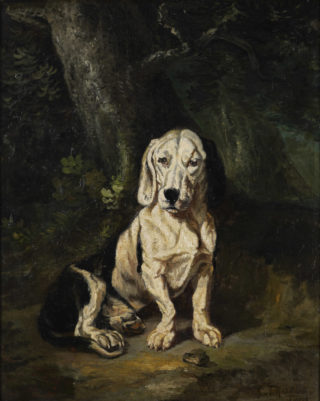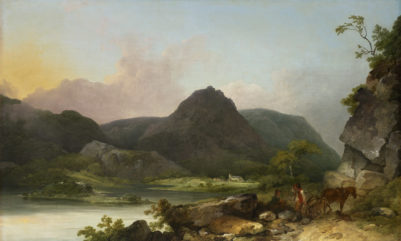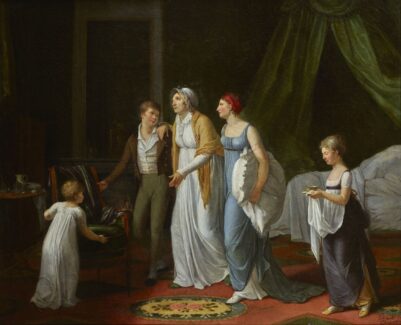
Sir Samuel Luke Fildes
Mrs Robert Borwick
Provenance:
Collection of Sir Robert Borwick; thence by descent to his son, George 2nd Baron Borwick (1880–1941) (until at least 1937).
Sale, Christie’s, London, 12 June 1992, lot 124.
Private collection, New York; sale, Sotheby’s, New York, 15 October 2020, lot 122, when acquired by the present owner.
Bibliography:
The Art Journal, 1890, p. 217.
Henry Blackburn, ed., Royal Academy Notes, 1890, p. 14 (as Portrait of Mrs Robert Borwick).
David Croal Thomson, The Life & Work of Luke Fildes, London, 1895, pp. 19 and 32.
Catalogue Entry

Fig.1. Luke Fildes, The Doctor, oil on canvas, 166 x 242 cm, 1891, Tate Gallery, London.
This marvellous female portrait exemplifies Samuel Luke Fildes’ refinement as a society portrait painter. Born in Liverpool in 1844, Fildes trained at the local Mechanics Institute and at the Warrington School of Art, before moving to London to study at the Kensington Art School and at the Academy Schools. The nephew of political activist Mary Fildes, Luke Fildes started off his career as an illustrator, joining The Graphic – a weekly social reform newspaper – in 1869, where he published images of the poor and homeless to raise awareness against social injustice. One of his engravings, Houseless and Hungry, was seen by John Everett Millais, who brought it to the attention of Charles Dickens, who retained Fildes to illustrate what would be his last novel, The Mystery of Edwin Drood. At the end of the 1870s, Fildes dedicated himself to painting and, in 1879, was elected an Associate Member of the Royal Academy. As Fildes’ popularity grew, in 1890 Sir Henry Tate commissioned him with a picture for his new National Gallery of British Art (today’s Tate Britain), The Doctor (Fig. 1), which became one of the best-selling paintings turned engravings of the Victorian era. By 1900, Fildes had become one of the most successful artists and the most highly paid portraitist in England. He portrayed several members of the Royal Family, including King Edward VII, Queen Alexandra and King George V. He was knighted in 1906 for his contribution to the arts.1

Fig. 2. Caroline Smith Johnston’s christening certificate, 1854.
The present portrait shows the more than a half-length figure of a woman placidly sitting on a sofa, looking out of the picture to her left. She wears a superb black evening gown, with jet beads and lace embellishing the lower and upper sections of the bodice, and black lace sleeves with cut-outs revealing the skin underneath. The dress’ silk skirt shows a refined tone-on-tone floral motif. The woman’s outfit is further enriched by jewellery: thin gold bracelets with rounded pendants, gold rings set with diamonds, two matching hair and bodice brooches, and a string of pearls at the neck. To complete the ensemble, she holds an elegant black and gilded fan in her hand. The sitter leans her right arm on a large pillow, while she rests her other arm on the voluminous skirt of her dress. The woman’s figure is set against a tapestry showing a portion of a landscape.

Fig. 3. Extract from a newspaper announcing the death of Lady Borwick, 1937.

Fig. 4. Picture of Lady Borwick, published on a newspaper following her death in London, 1937.
As the inscription on the canvas’ reverse reveals, she is indeed Mrs Robert Borwick, born Caroline Smith Johnston (1853–1936, Fig. 2). Caroline was the sixth daughter of Reverend Richard Daniel Johnston (1815–1885) of Madras, India, and his wife Susan Anne Farley (1821–1876). At the age of four, she and her family escaped the Indian mutiny and eventually arrived in England a few years later. On March 6, 1872, Caroline married new-money businessman Robert Hudson Borwick (1845–1936). Borwick was the chairman of the family firm George Borwick & Sons Ltd, which had been founded by his father George (1807–1889) in 1844. By the end of the century, the company had became a major English manufacturer of baking, egg, and custard powders, with a capital of £100,000 in 1902. In that year, Borwick was made a Knight Bachelor in 1902 and created a Baronet, of Eden Lacy in the County of Lancaster, in 1916. Since then, Caroline was styled as Baroness Borwick. Together, they had two sons and seven daughters. “Extremely fond of dogs and horses, and a lover of hunting,” as a contemporary newspaper describes her, (Fig. 3) Mrs Borwick resided in the village of Ilmington during the last seventeen years of her life (Fig. 4), while her husband relocated to France.2

Fig. 5. Dorothea Gertrude Borwick (née Grey), Lady Borwick; George Borwick, 2nd Baron Borwick by Bassano Ltd, whole-plate film negative, 20 May 1937, National Portrait Gallery, London.

Fig. 6. Detail of Fig. 5.
Although the circumstances of its execution remain unknown, the portrait is documented to have remained in the Borwick family’s collection until at least one year after Mrs Borwick passed away. This is proved by a photograph of Caroline’s first-born son George, 2nd Baron Borwick (1880–1941) and his second wife, Dorothea Gertrude Borwick (born Grey), taken in May 1937, possibly before the coronation of George VI (Fig. 5, National Portrait Gallery, London,). Caroline’s portrait is half visible on the right side of the picture, hanging on the wall (Fig. 6). Before entering the family’s private collection, the portrait was exhibited at the Royal Academy in 1890, the year of its execution. The portrait was displayed in Gallery IV together with paintings by Watts, Boughton, Cole and Sargent (Fig. 7). On that occasion, Fildes also exhibited his famous Portrait of Mrs Thomas Agnew (Fig. 8), which was located in Gallery III and described as “mauve dress, white brocade and lace” and a Portrait of a lady, displayed in Gallery V and described as “full length, standing, black dress with white lace.”3 Fildes’ participation in that year’s Academy was appreciated by the critics, with Claude Phillips from The Art Journal including him in the list of portraitists who “put their very best work into this branch of their art”4 and affirming that “Mr Luke Fildes has with exceptional success developed a branch of his art which, until he made his first essay some four years ago, was entirely unknown to him.”5

Fig. 7. Section of an illustration of the plan of the galleries from Henry Blackburn, ed., Academy Notes, 1890.
The positive reception of Mrs Robert Borwick is suggested by Fildes using a similar composition a few years later, when executing the portrait of London society hostess and racehorse breeder Mrs Arthur James (Fig. 9, Private collection) in 1895. The paintings can be closely compared: the two women are captured in a pose alike, sitting on a sofa, resting their arms on a broadly painted, voluminous silk pillow. They look sideways to their left, captured in a moment of rest during an evening reception. The painter’s signature appears, very similar, at the top left corner on a curtain that has replaced the tapestry of the present canvas. A similar tapestry with a tree appears as the background of another of Fildes’ female portraits, the Portrait of Mrs William Hesketh Lever (c.1851-1913), later 1st Lady Lever (Fig. 10, Lady Lever Art Gallery, Liverpool) from 1896. All three women wear fashionable formal black gowns, a colour which was associated with mourning during the nineteenth century. In Victorian age Britain, mourning dresses took a range of forms, from simple and understated to bold and arresting (Fig. 11), depending on the stages of mourning. Mrs Borwick had lost her father-in-low in 1889, the year before the portrait was executed. In 1890, she might have been in her latest stage of mourning, half-mourning, when discreet jewellery and precious fabrics were allowed. Her dress, for example, bears similarities with the gown worn by a widow in a satirical illustration by Charles Dana Gibson, dating to 1900-1901, from his series A Widow and her Friends (Fig. 12). This said, the possibility remains for the sitter to have consciously decided to wear a black gown for her portrait, with illustrious precedents including Ingres’s Portrait of Madam Leblanc (1823, The Metropolitan Museum of Art, New York). Furthermore, after Queen Victoria decided to wear black all her life following her husband death and after fashion magazines started to emphasize how stylish and chic mourning dress could be, black began to be associated with elegance, dignity and timelessness, and considered suitable for formal occasions (Fig. 13).6

Fig. 8. Luke Fildes, Mrs Thomas Agnew, oil on canvas, 59 x 44 cm, 1890, Private collection.

Fig. 9. Luke Fildes, Mrs Arthur James, oil on canvas, 143 x 105 cm, 1895, Private collection.

Fig. 10. Luke Fildes, Portrait of Mrs William Hesketh Lever (c.1851-1913), later 1st Lady Lever, oil on canvas, 119 x 84.3 cm, 1896, Lady Lever Art Gallery, Liverpool.

Fig. 11. Half-mourning evening dress made from black moiré silk, black jet and black lace, ca. 1861, The Metropolitan Museum of Art, New York.
Whether Mrs Borwick’s choice of black derived from the willingness to show respect for the loss of a family member or was, instead, a conscious affirmation of elegance, her portrait speaks of her refinement and dignity. Portrayed at the age of 37, the woman is resplendent in her gown, her figure appearing as vividly real thanks to Fildes’ masterful brushstrokes.

Fig. 13. Black silk and velvet evening gown with beads and sequins, 1908-1910. Designed by London dressmaker Barolet of Knightsbridge for Queen Alexandra, consort of King Edward VII.

Fig. 12. Illustration from Charles Dana Gibson, A Widow and Her Friends, New York, 1900-1901.
1 For a biographical study on Luke Fildes, see David Croal Thomson, The Life & Work of Luke Fildes, (London: J.S. Virtue & Co., 1895). 2 For a concise biography of Caroline Smith Johnston, see G.E. Cokayne; with Vicary Gibbs, H.A. Doubleday, Geoffrey H. White, Duncan Warrand and Lord Howard de Walden, editors, The Complete Peerage of England, Scotland, Ireland, Great Britain and the United Kingdom, Extant, Extinct or Dormant, new ed., 13 volumes in 14 (1910-1959; reprint in 6 volumes, Gloucester, U.K.: Alan Sutton Publishing, 2000), volume XIII, page 377. Hereinafter cited as The Complete Peerage. 3 Henry Blackburn, ed., Royal Academy Notes, 1890, pp. 12 and 15. 4 The Art Journal, 1890, p. 216: “Some of the acknowledged masters of portraiture, such as Mr. Watts, Sir J. E. Millais, Mr. J. Sargent, and Professor Herkomer, are conspicuously below their level this year; while others. Mr. W. Q. Orchard-son, Mr. Ouless, Mr. Luke Fildes, and such less widely-known portraitists as Mr. Lorimer and Mr. Jacomb-Hood, have put their very best work into this branch of their art.” 5 Ibid., p. 217. 6 For a detailed study on mourning dress in Europe and the United States, see Death Becomes Her, The Metropolitan Museum of Art, New York, October 21, 2014 - February 1, 2015.
Exhibited:
London, Royal Academy, 1890, no. 395.
Condition:
The painting is in good condition and is unlined. A slight craquelure is scattered across the surface and stretcher bar marks are visible. A few areas of retouching are visible under UV light in the figure’s face, as is some strengthening in the black dress.
The painting has been cleaned recently.



